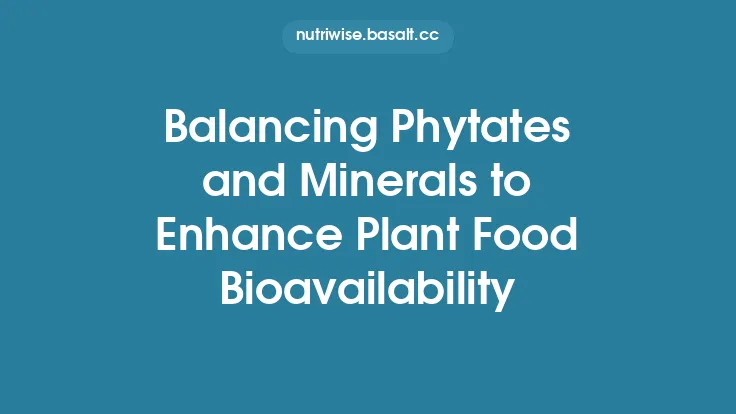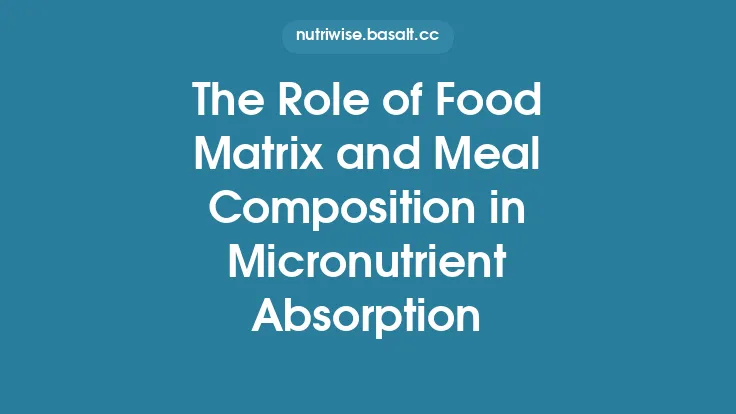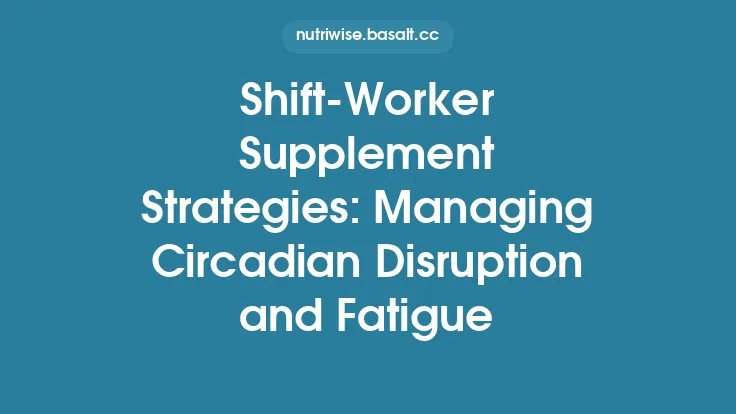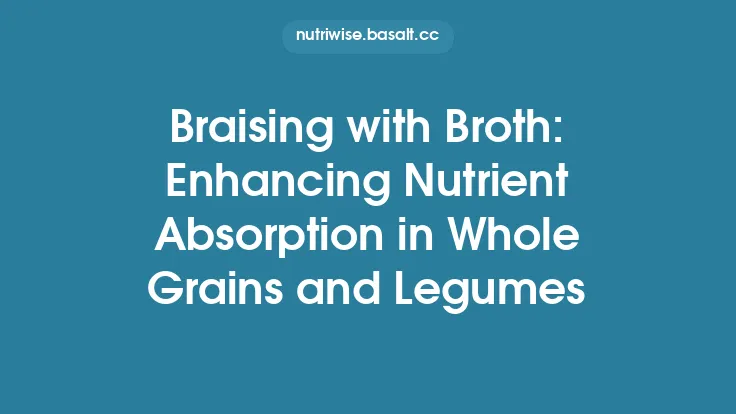Phytates (myo‑inositol hexakisphosphate) and oxalates (oxalic acid and its salts) are naturally occurring compounds found in a wide variety of plant foods. Both act as chelators, binding essential minerals such as calcium, iron, zinc, and magnesium, thereby reducing their solubility and intestinal absorption. While these compounds serve important physiological roles for the plant—defending against pests, regulating seed germination, and contributing to structural integrity—they can also pose challenges for human nutrition when consumed in large amounts or in poorly balanced diets. Understanding how phytates and oxalates interact with minerals, how the body adapts to their presence, and what practical strategies can be employed to mitigate their inhibitory effects is essential for anyone seeking to optimize micronutrient status without sacrificing the health benefits of plant‑rich eating patterns.
The Chemistry of Chelation: Why Phytates and Oxalates Inhibit Mineral Uptake
- Phytate Structure and Binding Sites
Phytate is a highly phosphorylated molecule with six phosphate groups, each bearing a negative charge at physiological pH. These anionic sites have a strong affinity for divalent cations (Ca²⁺, Fe²⁺/Fe³⁺, Zn²⁺, Mg²⁺). The resulting phytate‑mineral complexes are poorly soluble in the neutral to slightly alkaline environment of the small intestine, limiting passive diffusion and active transport mechanisms.
- Oxalate Structure and Precipitation
Oxalate exists as a dicarboxylate anion (C₂O₄²⁻) that readily forms insoluble salts with calcium (calcium oxalate) and, to a lesser extent, with magnesium and iron. Calcium oxalate crystals are the primary component of many kidney stones, illustrating the potency of oxalate’s binding capacity. In the gut lumen, calcium oxalate precipitates out, rendering both calcium and oxalate unavailable for absorption.
- pH Dependence
The solubility of phytate‑mineral complexes is pH‑dependent. In the acidic stomach (pH ≈ 1.5–3.5), some complexes may dissociate, but the majority remain intact through the duodenum where most mineral absorption occurs (pH ≈ 6–7). Oxalate‑calcium precipitation is favored at neutral to alkaline pH, making the small intestine a critical site for oxalate‑induced mineral loss.
Dietary Sources and Typical Intakes
| Compound | High‑Phytate Foods | High‑Oxalate Foods |
|---|---|---|
| Whole grains (e.g., wheat bran, rye) | 300–800 mg phytate/100 g | – |
| Legumes (e.g., soybeans, lentils) | 200–500 mg phytate/100 g | 20–50 mg oxalate/100 g |
| Nuts & seeds (e.g., almonds, sesame) | 150–400 mg phytate/100 g | 10–30 mg oxalate/100 g |
| Leafy greens (e.g., spinach, beet greens) | – | 500–1500 mg oxalate/100 g |
| Rhubarb, nuts, cocoa | – | 300–800 mg oxalate/100 g |
| Whole‑grain breads, cereals | 100–300 mg phytate/serving | – |
Average daily phytate intake in Western diets ranges from 600 mg to 1.5 g, while oxalate intake typically falls between 150 mg and 300 mg, though vegetarians and vegans may exceed 500 mg of oxalate per day due to higher consumption of leafy greens and nuts.
Physiological Adaptations to Phytate and Oxalate
- Endogenous Enzymes
Humans produce limited amounts of phytase (the enzyme that hydrolyzes phytate) in the small intestine, but the activity is insufficient to fully degrade dietary phytate. However, the gut microbiota—particularly certain Bifidobacterium and Lactobacillus strains—can express phytase, contributing to partial phytate breakdown. Regular consumption of fermented foods (e.g., tempeh, sourdough) can enhance this microbial phytase activity.
- Oxalate‑Degrading Bacteria
Oxalobacter formigenes, a specialized anaerobe, utilizes oxalate as its sole carbon source, thereby reducing intestinal oxalate load. Colonization rates vary widely (10–70 % in different populations) and are influenced by antibiotic exposure, diet, and gut health. A robust O. formigenes population can lower urinary oxalate excretion and mitigate stone risk.
- Regulation of Mineral Transporters
The body can up‑regulate active transporters (e.g., DMT1 for iron, ZIP4 for zinc) in response to low luminal availability, but this compensatory mechanism has limits and may be insufficient when phytate or oxalate concentrations are high.
Strategies to Reduce Phytate‑Induced Mineral Inhibition
- Soaking and Sprouting
- Mechanism: Soaking seeds, legumes, and grains in water (pH ≈ 6–7) for 8–24 hours activates endogenous phytase, hydrolyzing up to 50 % of phytate. Sprouting further enhances phytase activity and reduces phytate content by 30–70 %.
- Practical tip: Discard the soaking water (which contains released phytate‑mineral complexes) and rinse before cooking.
- Fermentation
- Mechanism: Lactic‑acid bacteria produce phytase and organic acids that lower pH, promoting phytate breakdown. Fermented products such as sourdough bread, tempeh, and miso can have phytate reductions of 40–80 %.
- Practical tip: Use a sourdough starter with a mature microbial community; longer fermentation (12–24 h) yields greater phytate loss.
- Thermal Processing with Acidic Medium
- Mechanism: Boiling legumes in slightly acidic water (adding a teaspoon of lemon juice or vinegar per liter) can improve phytate solubility and facilitate leaching. However, excessive heat alone does not significantly degrade phytate.
- Practical tip: Combine soaking, acidified boiling, and discarding the cooking water for maximal effect.
- Enzyme Supplementation
- Mechanism: Commercial phytase supplements (derived from Aspergillus niger or fungal sources) can be added to meals, especially in high‑phytate diets (e.g., vegan athletes). Typical doses range from 200–500 FTU (phytase units) per serving.
- Consideration: Enzyme activity is optimal at pH ≈ 5.5–6.0 and temperatures of 45–55 °C; timing of addition (during cooking) matters.
Strategies to Reduce Oxalate‑Induced Mineral Inhibition
- Calcium Co‑Consumption
- Mechanism: Adding calcium (e.g., dairy, calcium‑fortified plant milks) to oxalate‑rich meals promotes the formation of insoluble calcium oxalate in the gut lumen, which is then excreted in feces rather than absorbed. This simultaneously reduces oxalate absorption and preserves calcium availability.
- Practical tip: Pair a cup of cooked spinach with a serving of cheese or a calcium‑rich dressing.
- Boiling and Discarding Water
- Mechanism: Oxalate is water‑soluble; boiling leafy greens for 2–5 minutes can leach out 30–50 % of total oxalate, especially when the water is changed or discarded.
- Practical tip: Use a large volume of water (≥ 1 L per 100 g of greens) and avoid reusing the cooking liquid.
- Probiotic Support for Oxalate‑Degrading Bacteria
- Mechanism: Regular intake of probiotic strains that support O. formigenes (e.g., certain Lactobacillus spp.) can enhance intestinal oxalate degradation.
- Practical tip: Include fermented foods such as kefir, kombucha, or probiotic supplements containing Lactobacillus plantarum.
- Limiting High‑Oxalate Foods in Sensitive Individuals
- Mechanism: For people with a history of calcium oxalate kidney stones or hyperoxaluria, reducing intake of foods with > 300 mg oxalate per 100 g (e.g., raw spinach, rhubarb, beet greens) is advisable.
- Practical tip: Substitute with lower‑oxalate greens such as kale, bok choy, or collard greens.
Balancing Both Inhibitors in a Single Meal
When a meal contains both phytate‑rich and oxalate‑rich components (e.g., a bean‑and‑spinach stew), the following integrated approach can optimize mineral bioavailability:
- Step 1: Pre‑treat legumes – Soak and sprout beans overnight, discard soaking water, then cook in fresh water with a splash of lemon juice.
- Step 2: Prepare greens – Blanch spinach briefly, then shock in ice water; discard the blanching water to remove soluble oxalate.
- Step 3: Add calcium source – Stir in a modest amount of cheese, yogurt, or calcium‑fortified tofu toward the end of cooking to bind residual oxalate.
- Step 4: Ferment or use sourdough – If the dish includes grains (e.g., brown rice), consider serving it with a side of sourdough bread to provide additional phytase activity.
- Step 5: Finish with probiotic‑rich garnish – Top the stew with a spoonful of kefir or a fermented vegetable relish to support oxalate‑degrading microbes.
Quantifying the Impact: How Much Can Bioavailability Improve?
- Phytate Reduction – Studies using combined soaking, sprouting, and fermentation have reported up to a 70 % increase in zinc and iron absorption from legumes, as measured by stable‑isotope tracer techniques.
- Oxalate Management – Co‑consumption of 500 mg calcium with 300 mg oxalate reduced urinary oxalate excretion by ~30 % in controlled feeding trials, while preserving calcium absorption at > 80 % of the baseline.
These figures illustrate that strategic food preparation can meaningfully shift the balance from inhibition toward absorption, without eliminating the health‑promoting phytochemicals that accompany phytates and oxalates.
Practical Meal Planning Templates
| Meal | Phytate‑Managing Technique | Oxalate‑Managing Technique | Calcium Source |
|---|---|---|---|
| Breakfast: Overnight oats with chia seeds, almond milk, and berries | Soak oats & chia overnight (phytase activation) | Use low‑oxalate berries (e.g., blueberries) | Add a splash of fortified soy milk (≈ 200 mg Ca) |
| Lunch: Quinoa‑black bean salad with kale and feta | Rinse quinoa, cook in excess water, discard | Blanch kale briefly, discard water | Crumble feta (≈ 150 mg Ca) |
| Dinner: Lentil‑spinach curry with brown rice | Sprout lentils 12 h before cooking | Boil spinach, discard water | Serve with a side of yogurt (≈ 250 mg Ca) |
| Snack: Hummus with carrot sticks | Use canned chickpeas (canned processing reduces phytate) | Carrots are low‑oxalate | Add tahini (sesame) for additional calcium |
Monitoring and Individualization
- Biomarker Assessment – Serum ferritin, zinc, and magnesium levels can indicate chronic mineral deficiencies. Urinary oxalate excretion (24‑hour collection) helps gauge oxalate load, especially in stone‑prone individuals.
- Dietary Tracking – Apps that log phytate and oxalate content can assist those on restrictive regimens (e.g., renal diets). However, most healthy adults benefit from general preparation strategies rather than precise counting.
- Gut Microbiome Considerations – If frequent antibiotic use or gastrointestinal disturbances are present, probiotic or fermented food supplementation becomes more critical to maintain phytate‑degrading and oxalate‑degrading bacterial populations.
Bottom Line
Phytates and oxalates are inherent components of many nutritious plant foods, and their mineral‑binding properties can pose absorption challenges. By employing time‑tested culinary techniques—soaking, sprouting, fermentation, strategic cooking, and thoughtful pairing with calcium—individuals can substantially diminish the inhibitory impact of these compounds. Coupled with support for a diverse gut microbiome, these practices enable the continued enjoyment of phytate‑ and oxalate‑rich foods while safeguarding the bioavailability of essential micronutrients such as iron, zinc, calcium, and magnesium. The result is a balanced, plant‑forward diet that maximizes nutritional benefit without compromising mineral status.





